| The type locality of the peculiar curved joint pattern (Images A, B) has been found by H. Müller in the course of his diploma thesis mapping at the south-western ring of the Azuara impact structure (UTM coordinates, 684500/4555400, near Moneva) some 15 km from its center. The exposure shows fossiliferous Dogger limestones, which have undergone strong brittle fracturing. The joint sets under discussion are well exposed by their strong curvature. Two evidently conjugate sets with parallel strike form a system, which is nearly symmetrical to the vertical, and cut the rock into bars of approximately rhomboid shape. This often results in a rhomboid-within-rhomboid structure. Small displacements with slickensides parallel to dip have been observed to occur on the order of centimeters. |
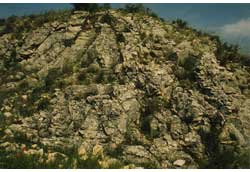 A A |
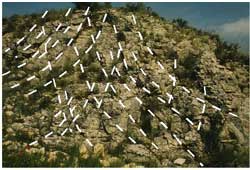 B B |
| Proceeding with field examinations, more joint systems with quite similar shape were found throughout the ring terrain of the Azuara structure. However, in contrast with the sets in Image A , the curved joints in Image C (south of Belchite) display counter convexity, and Image D (near Almonacid de la Cuba) shows the phenomenon on a smaller scale with a more irregular pattern. |
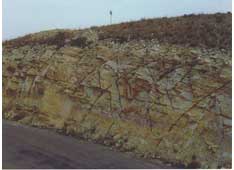 C C |
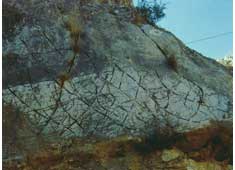 D D |
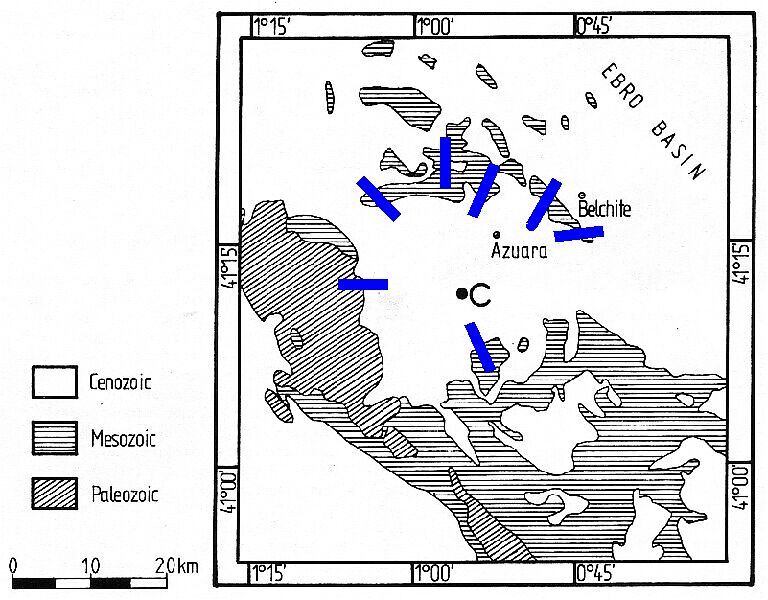 |
E: All locations are displayed in Image E where the strike directions of the curved sets are plotted. Although statistically only weakly exemplified, there is a trend of radial strike related to the center of the impact structure |
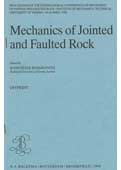 Discussion. – In contrast to well established rhomboid structures resulting from the intersection of linear joints, strongly curved conjugate joint sets producing rhomboid-within-rhomboid structures are virtually unknown up to now. In a proceedings paper, pp. 257-263 (Image F), Müller and Ernstson excluded a relation to listric faulting, a formation by sedimentational and diagenetic processes, and presented a model of a dynamic formation which considers the modulation of running fractures in the impact cratering process. According to this model, the stress field of the shock-driven excavation flow combines with the stress field of the rising rarefaction pulse to a time-varying stress field causing the propagation of fractures along curved paths. Such a process is well known in experimental fracture mechanics: The modulation of a running fracture by ultra-sonic waves produces an undulating fracture surface.In our paper, we compute and show that in the early (excavation) stage of the impact cratering process, the conditions of the formation of curved conjugate joint sets can be met locally and during a short period of time.The model is not only consistent with the Azuara observations (radial strike with respect to the center, convex and concave curvature, different radii of curvature, rhomboid-within-rhomboid structures) but also predicts curved joint sets to belong to the regular structural inventory of impact craters. Discussion. – In contrast to well established rhomboid structures resulting from the intersection of linear joints, strongly curved conjugate joint sets producing rhomboid-within-rhomboid structures are virtually unknown up to now. In a proceedings paper, pp. 257-263 (Image F), Müller and Ernstson excluded a relation to listric faulting, a formation by sedimentational and diagenetic processes, and presented a model of a dynamic formation which considers the modulation of running fractures in the impact cratering process. According to this model, the stress field of the shock-driven excavation flow combines with the stress field of the rising rarefaction pulse to a time-varying stress field causing the propagation of fractures along curved paths. Such a process is well known in experimental fracture mechanics: The modulation of a running fracture by ultra-sonic waves produces an undulating fracture surface.In our paper, we compute and show that in the early (excavation) stage of the impact cratering process, the conditions of the formation of curved conjugate joint sets can be met locally and during a short period of time.The model is not only consistent with the Azuara observations (radial strike with respect to the center, convex and concave curvature, different radii of curvature, rhomboid-within-rhomboid structures) but also predicts curved joint sets to belong to the regular structural inventory of impact craters. |












































































